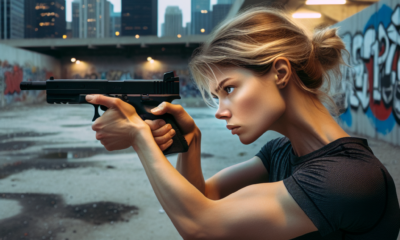Womens Firearms
Aim, Shoot, Repeat: The Women Dominating the Shooting Range
Hello, ladies! I’m Jade Tripp, and today we’re diving into a thrilling topic that’s gaining momentum across the country: women dominating the shooting range! The shooting sports have historically been male-dominated, but that’s changing, and I couldn’t be more excited to see more women stepping up, taking aim, and embracing their power.
Breaking Stereotypes
First and foremost, let’s address the elephant in the room: the outdated notion that hunting and shooting are “men’s activities.” Women are breaking through those stereotypes every day. Just look at women like Jessie Harrison, a competitive shooter, who has not only earned numerous championship titles but is also a powerful advocate for women in firearms. Jessie started shooting at a young age and has become a role model for many, proving that this is a sport where determination and skill reign supreme, regardless of gender.
The Rise of Women in Shooting Sports
Organizations like The Well Armed Woman (TWAW) have dedicated themselves to welcoming women into this exciting world. TWAW offers classes and workshops, helping novices feel comfortable and confident on the range. I can’t stress enough how vital community support is. When women come together, share experiences, and provide encouragement, magic happens!
Take Megan Hunt, for instance. She joined a local shooting group two years ago, where she faced her fears and learned the ropes of shooting. Not only did she acquire a new skill, but she also found a supportive community of friends and mentors. Today, she’s an avid sport shooter and wouldn’t trade her experiences for anything!
Choosing the Right Firearm
Finding the right firearm can be daunting, but it’s all about what feels comfortable for you. Many women find success with compact handguns for self-defense or rifles for sport shooting. For beginners, I often recommend starting with a .22 caliber for practice since it has less recoil and allows for ample practice without breaking the bank.
Tip: Always test several firearms at your local range. It’s okay to ask for help from instructors or more experienced shooters—everyone is there to learn!
Safety First
Safety is paramount when handling firearms. Taking a basic safety course is essential. You’ll learn crucial aspects like firearm handling, proper storage, and maintenance. Remember, knowledge is your best defense!
I urge you to look into local classes—many ranges offer courses specifically tailored for women. For example, The Shooting Range in Los Angeles has female instructors who create comfortable environments for women to learn.
Joining the Community
With the rise of female presence in shooting sports, many events focus on women. For example, the Ladies’ Night at shooting ranges is becoming increasingly popular. These events foster networking and camaraderie while providing a relaxed setting to learn and improve skills.
You might also want to check out events like Women on Target, offering unique shooting experiences and classes. These opportunities can help you hone your skills while connecting with like-minded women who share your passion.
Real-Life Inspiration
Let’s highlight one more powerhouse: Amanda Furrer, a professional three-gun competitor, who impressively balances being a mother and an athlete. Amanda embodies the spirit of perseverance in the face of challenges. She is celebrated for her achievements in competitive shooting and continually advocates for women’s participation in the sport.
In Conclusion
Ladies, whether you’re a seasoned shooter or just beginning to explore this exhilarating world, remember that every time you step onto the range, you’re part of a growing movement. You are not just aiming at targets; you are aiming for empowerment, confidence, and community.
So, grab your gear, gather your friends, and let’s aim, shoot, and repeat with pride! You’ve got this!
Stay safe, stay confident, and keep shooting!
Warmly,
Jade Tripp
Womens Firearms
The Psychology of Home Invasions: Understanding the Mind of an Intruder

Hello, ladies! I’m Jade Tripp, and today I want to dive into a topic that not only enforces the importance of self-defense but also arms us with knowledge—knowledge that can empower us to protect ourselves and our homes. Understanding the psychology behind home invasions is crucial for identifying potential threats and responding effectively.
The Intruder’s Mindset
To comprehend the psychological profile of an intruder, we first need to acknowledge that most home invasions are crimes of opportunity. The intruder often looks for easy targets—homes that present minimal risk and maximum reward. This could include:
- Visible signs of vulnerability: Unlocked doors, windows left open, or even cluttered pathways that suggest no one is home can all serve as invitations for an intruder.
- Routine observation: Many intruders will scout neighborhoods to note residents’ schedules and habits. If they see you consistently leaving for work at the same time, they might choose that moment to strike.
Real-Life Example: A Neighbor’s Story
Take the story of Sarah, a single mom living in a quiet suburb. She often left her back door unlocked during the day while playing with her children in the front yard. An intruder, having observed her routine, took advantage of this vulnerability one afternoon. Thankfully, Sarah was alerted by her barking dog and was able to scare the intruder off. This experience has allowed Sarah to become an advocate for home safety in her community, encouraging other women to never underestimate the significance of securing their homes.
Understanding Their Motives
Most home invaders are not only after valuables but also possess a psychological profile that can vary widely. Some common motives include:
-
Financial Gain: This is the primary motivation behind most break-ins. Intruders will look for cash, jewelry, electronics, or even prescription drugs.
-
Dare or Thrill-Seekers: Some invaders may be motivated by the adrenaline rush rather than monetary gain. The "game" aspect of breaking into homes can sometimes be appealing to certain individuals.
- Targeted Individuals: Occasionally, intruders may have a personal vendetta. This could be against a former partner or someone they feel has wronged them, making it essential to recognize warning signs in personal relationships.
A Notable Case: The Impact of Personal History
Consider the infamous case of the “North Carolina Burglar,” who was eventually caught due to his personal history of family disputes and targeted attacks. His story reminds us that intruders may have deeper psychological issues stemming from their past, which can lead them to commit such acts. It emphasizes the importance of knowing your surroundings and being aware of any potential threats.
Prevention Tactics
Understanding an intruder’s mindset can help us take crucial preventive measures. Here are a few strategies that can make your home less appealing to potential intruders:
-
Secure All Entry Points: Install deadbolts and security systems. Simple things like window locks and door security bars can deter unwanted visitors.
-
Create Illusion of Occupancy: Utilize timers on lights, or have neighbors keep an eye on your home when you’re out, making it look like someone is home.
-
Build a Community: Get to know your neighbors. A close-knit community can serve as an excellent deterrent as people look out for one another.
- Self-Defense Training: Knowing how to defend yourself gives you confidence and prepares you for the worst-case scenario. Organizations like the Rape Aggression Defense (RAD) program offer valuable courses specifically designed for women.
Sharing Strength
Remember, ladies, it’s essential to discuss these topics not just in private settings but also openly in community forums and workshops. Sharing stories and insights helps create awareness and fosters a strong sense of community support. Just like Sarah did—her experience turned into a powerful lesson for many, encouraging self-defense workshops and neighborhood watch groups.
Conclusion
Understanding the psychology of home invasions can equip us with the tools and knowledge needed to safeguard ourselves and our loved ones. It’s crucial to take proactive steps to fortify our homes, but even more important is the mindset we cultivate as women. Remember, you are not alone in this, and together, we can create a safe environment for ourselves and our communities.
Stay empowered, stay informed, and let’s keep the conversation going. Until next time, take care of yourselves and each other!
Warmly,
Jade Tripp
Womens Firearms
"Understanding the Laws: Concealed Handgun Permit Requirements"

Hello, ladies! It’s Jade Tripp here, and today we’re diving into a vital topic for any woman considering self-defense options: understanding the laws surrounding concealed handgun permit requirements. Knowing the ins and outs of these laws is empowering, and it equips us with the knowledge we need to take charge of our safety.
Why It Matters
Before we get into the specifics, let’s acknowledge why understanding these laws is crucial. As women, it’s important to feel secure in your environment, whether you’re heading home late from work, out jogging in your neighborhood, or simply running errands. Owning a firearm for protection can be a viable option, but only if you do it legally and responsibly.
The Legal Landscape
Concealed carry laws vary significantly from state to state, so it’s vital to understand the regulations in your specific location. Let’s break this down:
1. Eligibility Requirements
Most states have eligibility requirements for obtaining a concealed handgun permit (CHP). Common criteria include:
- Age: Generally, you must be at least 21 years old.
- Residency: Many states require you to be a resident of that state. For example, California mandates an applicant to be a resident of the county in which they apply.
- Background Check: Many states perform a criminal background check to ensure applicants do not have felony convictions or documented mental health issues.
Example: In Ohio, you must complete a background check and also have no major criminal charges within the past several years.
2. Training Requirements
Most states require some form of training or education. This can vary from basic firearm safety courses to more intensive self-defense training.
- Training Courses: Look for state-approved training facilities. In Texas, for example, you need to complete a four to six-hour training course followed by a shooting proficiency demonstration.
Example: Many women find empowerment in taking women’s self-defense courses which not only teach you how to handle a firearm but also provide practical self-defense strategies.
3. Application Process
The process can include filling out forms, submitting proof of training, and paying a fee.
- Documentation: You may need to provide identification, training certificates, and sometimes, proof of residency.
In Florida, the process is fairly streamlined; you submit an application, fingerprint your documents, and wait for approval, which can take anywhere from a few weeks to a few months.
4. Permits and Renewal
Once you have your permit, be aware of its validity and the process for renewal. Most states require periodic renewal every few years, which may involve a refresher course or re-application.
Example: In Illinois, concealed carry permits are valid for five years before they need to be renewed, and renewal requires completing training similar to the original training.
5. Where You Can Carry
Understanding where you can legally carry your concealed firearm is crucial. Some places may have restrictions, including government buildings, schools, and establishments that serve alcohol.
Example: In many states, you cannot carry in schools or on public transportation. It’s essential to be familiar with your state’s specific regulations to avoid accidental legal infractions.
Final Thoughts
I encourage every woman out there to educate themselves on these requirements, join a local self-defense class, and talk with other women in your community who may have gone through this process.
Empower Yourself!
Remember, the goal is not just to carry, but to feel empowered and equipped to protect yourself. Surrounding yourself with female instructors or finding a supportive community can make a world of difference. Organizations like The Well Armed Woman and A Girl & A Gun provide resources, camaraderie, and education.
By understanding the laws and taking the necessary steps, you are part of a growing movement of empowered women exercising their rights to self-defense. Stay safe, stay informed, and most importantly, stay confident!
Let’s take control of our safety together! Happy protecting! 🛡️💪
Womens Firearms
Women of India Demand Firearms: Addressing Safety Concerns

In response to inadequate police protection, Indian women are rallying for their right to bear arms. We explore the implications of …
source
-

 Womens Self Defense11 months ago
Womens Self Defense11 months agoNew Legislation Empowers Women to Defend Themselves
-

 Self Defense News1 year ago
Self Defense News1 year agoShe was convicted of killing her abusive boyfriend. Now a Maple Grove woman is home awaiting a new trial.
-

 Self Defense News1 year ago
Self Defense News1 year agoSelf-Defense for All: The new Gracie Jiu-Jitsu Pasadena is for everyone | Online Features
-

 Womens Self Defense1 year ago
Womens Self Defense1 year agoTop 5 Self-Defense Techniques Every Woman Should Know
-

 Womens Self Defense7 months ago
Womens Self Defense7 months agoUnderstanding State-by-State Variation in Self Defense Laws
-

 Womens Fitness1 year ago
Womens Fitness1 year agoXtreme Bodyweight HIIT (Lots of Jumping!) | Joanna Soh (Fio Series)
-

 Womens Preparedness1 year ago
Womens Preparedness1 year ago10 essential skills for surviving in the great outdoors
-

 Womens Preparedness1 year ago
Womens Preparedness1 year agoEmpower Yourself: A Guide to Female Survival Planning









